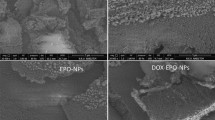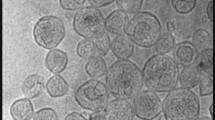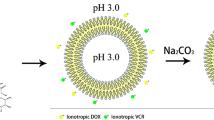Summary
The ability of cancer cells to become simultaneously resistant to different drugs, a trait known as multidrug resistance, remains a major obstacle for successful anticancer therapy. One major mechanism of resistance involves cellular drug efflux by expression of P-glycoprotein (P-gp), a membrane transporter with a wide variety of substrates. Anthracyclines are especially prone to induction of resistance by the P-gp mechanism. P-gp mediated resistance is often confronted by use of P-gp inhibitors, synthesis of novel analogs, or conjugating drugs to macromolecular carriers in order to circumvent the efflux mechanism. In this report, the effect of free and Elastin-like polypeptide (ELP) bound doxorubicin (Dox) on the viability of sensitive (MES-SA and MCF-7) and multidrug resistant (MES-SA/Dx5 and NCI/ADR-RES) human carcinoma cells was studied in vitro. The resistant MES-SA/Dx5 cells demonstrated about 70 times higher resistance to free Dox than the sensitive MES-SA cells, and the NCI/ADR-RES cells were about 30 fold more resistant than the MCF-7 cells. However, the ELP-bound Dox was equally cytotoxic in both sensitive and resistant cell lines. The ELP-bound Dox was shown to accumulate in MES-SA/Dx5 cells, as opposed to free Dox, which was rapidly pumped out by the P-gp transporter. Since ELP is a thermally responsive carrier, the effect of hyperthermia on the cytotoxicity of the ELP-Dox conjugate was investigated. Both cytotoxicity and apoptosis were enhanced by hyperthermia in the Dox resistant cells. The results suggest that ELP-Dox conjugates may provide a means to thermally target solid tumors and to overcome drug resistance in cancer cells.







Similar content being viewed by others
Abbreviations
- ABC:
-
ATP binding cassette
- AUC:
-
area under curve
- BSA:
-
bovine serum albumin
- Dnr:
-
daunorubicin
- Dox:
-
doxorubicin
- ELP:
-
elastin-like polypeptide
- EPR:
-
enhanced permeability and retention
- HPLC:
-
high pressure liquid chromatography
- HPMA:
-
N-(2-hydroxypropyl)methacrylamide
- MDR:
-
multidrug resistance
- PBS:
-
phosphate buffered physiological saline
- PE:
-
phycoerythrin
- PFA:
-
paraformaldehyde
- P-gp:
-
P-glycoprotein
- Tt :
-
transition temperature
References
Fojo AT, Menefee M (2005) Microtubule targeting agents: basic mechanisms of multidrug resistance (MDR). Semin Oncol 32(6–7):S3–S8
Beck WT, Danks MK, Wolverton JS, Granzen B, Chen M, Schmidt CA, Bugg BY, Friche E, Suttle DP (1993) Altered DNA topoisomerase II in multidrug resistance. Cytotechnology 11(2):115–119
Bosch TM, Meijerman I, Beijnen JH, Schellens JH (2006) Genetic polymorphisms of drug-metabolising enzymes and drug transporters in the chemotherapeutic treatment of cancer. Clin Pharmacokinet 45(3):253–85
Duvvuri M, Krise JP (2005) Intracellular drug sequestration events associated with the emergence of multidrug resistance: a mechanistic review. Front Biosci 10:1499–1509
Stein WD, Bates SE, Fojo T (2004) Intractable cancers: the many faces of multidrug resistance and the many targets it presents for therapeutic attack. Curr Drug Targets 5(4):333–346
Dano K (1973) Active outward transport of daunomycin in resistant Ehrlich ascites tumor cells. Biochim Biophys Acta 323(3):466–483
Willingham MC, Cornwell MM, Cardarelli CO, Gottesman MM, Pastan I (1986) Single cell analysis of daunomycin uptake and efflux in multidrug-resistant and -sensitive KB cells: effects of verapamil and other drugs. Cancer Res 46(11):5941–5946
Szakacs G, Paterson JK, Ludwig JA, Booth-Genthe C, Gottesman MM (2006) Targeting multidrug resistance in cancer. Nat Rev Drug Discov 5(3):219–234
Juliano RL, Ling V (1976) A surface glycoprotein modulating drug permeability in Chinese hamster ovary cell mutants. Biochim Biophys Acta 455(1):152–162
Higgins CF (1992) ABC transporters: from microorganisms to man. Annu Rev Cell Biol 8:67–113
Raviv Y, Pollard HB, Bruggemann EP, Pastan I, Gottesman MM (1990) Photosensitized labeling of a functional multidrug transporter in living drug-resistant tumor cells. J Biol Chem 265(7):3975–3980
Mickley LA, Spengler BA, Knutsen TA, Biedler JL, Fojo T (1997) Gene rearrangement: a novel mechanism for MDR-1 gene activation. J Clin Invest 99(8):1947–1957
Abolhoda A, Wilson AE, Ross H, Danenberg PV, Burt M, Scotto KW (1999) Rapid activation of MDR1 gene expression in human metastatic sarcoma after in vivo exposure to doxorubicin. Clin Cancer Res 5(11):3352–3356
Seelig A (1998) A general pattern for substrate recognition by P-glycoprotein. Eur J Biochem 251(1–2):252–261
Ambudkar SV, Dey S, Hrycyna CA, Ramachandra M, Pastan I, Gottesman MM (1999) Biochemical, cellular, and pharmacological aspects of the multidrug transporter. Annu Rev Pharmacol Toxicol 39:361–398
Ozben T (2006) Mechanisms and strategies to overcome multiple drug resistance in cancer. FEBS Lett 580(12):2903–2909
Harker WG, MacKintosh FR, Sikic BI (1983) Development and characterization of a human sarcoma cell line, MES-SA, sensitive to multiple drugs. Cancer Res 43(10):4943–4950
Harker WG, Sikic BI (1985) Multidrug (pleiotropic) resistance in doxorubicin-selected variants of the human sarcoma cell line MES-SA. Cancer Res 45(9):4091–4096
Borowski E, Bontemps-Gracz MM, Piwkowska A (2005) Strategies for overcoming ABC-transporters-mediated multidrug resistance (MDR) of tumor cells. Acta Biochim Pol 52(3):609–627
Priebe W, Van NT, Burke TG, Perez-Soler R (1993) Removal of the basic center from doxorubicin partially overcomes multidrug resistance and decreases cardiotoxicity. Anticancer Drugs 4(1):37–48
Priebe W, Perez-Soler R (1993) Design and tumor targeting of anthracyclines able to overcome multidrug resistance: a double-advantage approach. Pharmacol Ther 60(2):215–234
Priebe W (1995) Mechanism of action-governed design of anthracycline antibiotics: a “turn-off/turn-on” approach. Curr Pharm Des 1:51–68
Consoli U, Priebe W, Ling YH, Mahadevia R, Griffin M, Zhao S, Perez-Soler R, Andreeff M (1996) The novel anthracycline annamycin is not affected by P-glycoprotein-related multidrug resistance: comparison with idarubicin and doxorubicin in HL-60 leukemia cell lines. Blood 88(2):633–644
Krishna R, Mayer LD (1999) The use of liposomal anticancer agents to determine the roles of drug pharmacodistribution and P-glycoprotein (PGP) blockade in overcoming multidrug resistance (MDR). Anticancer Res 19(4B):2885–2891
Vail DM, Amantea MA, Colbern GT, Martin FJ, Hilger RA, Working PK (2004) Pegylated liposomal doxorubicin: proof of principle using preclinical animal models and pharmacokinetic studies. Semin Oncol 31(6–13):16–35
Brigger I, Dubernet C, Couvreur P (2002) Nanoparticles in cancer therapy and diagnosis. Adv Drug Deliv Rev 54(5):631–651
Mayer LD, Shabbits JA (2001) The role for liposomal drug delivery in molecular and pharmacological strategies to overcome multidrug resistance. Cancer Metastasis Rev 20(1–2):87–93
Minko T, Kopeckova P, Pozharov V, Kopecek J (1998) HPMA copolymer bound adriamycin overcomes MDR1 gene encoded resistance in a human ovarian carcinoma cell line. J Control Release 54(2):223–233
Ohkawa K, Hatano T, Yamada K, Joh K, Takada K, Tsukada Y, Matsuda M (1993) Bovine serum albumin-doxorubicin conjugate overcomes multidrug resistance in a rat hepatoma. Cancer Res 53(18):4238–4242
Kopecek J, Kopeckova P, Minko T, Lu Z (2000) HPMA copolymer-anticancer drug conjugates: design, activity, and mechanism of action. Eur J Pharm Biopharm 50(1):61–81
Kopecek J (2003) Smart and genetically engineered biomaterials and drug delivery systems. Eur J Pharm Sci 20(1):1–16
Cassidy J, Duncan R, Morrison GJ, Strohalm J, Plocova D, Kopecek J, Kaye SB (1989) Activity of N-(2-hydroxypropyl)methacrylamide copolymers containing daunomycin against a rat tumour model. Biochem Pharmacol 38(6):875–879
Maeda H, Seymour LW, Miyamoto Y (1992) Conjugates of anticancer agents and polymers: advantages of macromolecular therapeutics in vivo. Bioconjug Chem 3(5):351–362
Takakura Y, Fujita T, Hashida M, Sezaki H (1990) Disposition characteristics of macromolecules in tumor-bearing mice. Pharm Res 7(4):339–346
Yamaoka T, Tabata Y, Ikada Y (1994) Distribution and tissue uptake of poly(ethylene glycol) with different molecular weights after intravenous administration to mice. J Pharm Sci 83(4):601–606
Minko T, Kopeckova P, Kopecek J (1999) Comparison of the anticancer effect of free and HPMA copolymer-bound adriamycin in human ovarian carcinoma cells. Pharm Res 16(7):986–996
St’astny M, Strohalm J, Plocova D, Ulbrich K, Rihova B (1999) A possibility to overcome P-glycoprotein (PGP)-mediated multidrug resistance by antibody-targeted drugs conjugated to N-(2-hydroxypropyl)methacrylamide (HPMA) copolymer carrier. Eur J Cancer 35(3):459–466
Ryser HJ, Shen WC (1978) Conjugation of methotrexate to poly(L-lysine) increases drug transport and overcomes drug resistance in cultured cells. Proc Natl Acad Sci U S A 75(8):3867–3870
Bidwell GL 3rd, Fokt I, Priebe W, Raucher D (2007) Development of elastin-like polypeptide for thermally targeted delivery of doxorubicin. Biochem Pharmacol 73(5):620–631
Urry DW, Luan C-H, Parker TM, Gowda DC, Prasad KU, Reid MC, Safavy A (1991) Temperature of polypeptide inverse temperature transition depends on mean residue hydrophobicity. J Am Chem Soc 113:4346–4348
Urry DW (1992) Free energy transduction in polypeptides and proteins based on inverse temperature transitions. Prog Biophys Mol Biol 57(1):23–57
Raucher D, Chilkoti A (2001) Enhanced uptake of a thermally responsive polypeptide by tumor cells in response to its hyperthermia-mediated phase transition. Cancer Res 61(19):7163–7170
Chilkoti A, Dreher MR, Meyer DE (2002) Design of thermally responsive, recombinant polypeptide carriers for targeted drug delivery. Adv Drug Deliv Rev 54(8):1093–1111
Dreher MR, Raucher D, Balu N, Michael Colvin O, Ludeman SM, Chilkoti A (2003) Evaluation of an elastin-like polypeptide-doxorubicin conjugate for cancer therapy. J Control Release 91(1–2):31–43
Liu W, Dreher MR, Furgeson DY, Peixoto KV, Yuan H, Zalutsky MR, Chilkoti A (2006) Tumor accumulation, degradation and pharmacokinetics of elastin-like polypeptides in nude mice. J Control Release 116(2):170–178
Meyer DE, Kong GA, Dewhirst MW, Zalutsky MR, Chilkoti A (2001) Targeting a genetically engineered elastin-like polypeptide to solid tumors by local hyperthermia. Cancer Res 61(4):1548–1554
Vives E, Brodin P, Lebleu B (1997) A truncated HIV-1 Tat protein basic domain rapidly translocates through the plasma membrane and accumulates in the cell nucleus. J Biol Chem 272(25):16010–16017
Massodi I, Bidwell GL, 3rd, Raucher D (2005) Evaluation of cell penetrating peptides fused to elastin-like polypeptide for drug delivery. J Control Release 108(2–3):396–408
Duncan R, Cable HC, Lloyd JB, Rejmanova P, Kopecek J (1982) Degradation of side-chains of N-(2-hydroxypropyl)methacrylamide copolymers by lysosomal thiol-proteinases. Biosci Rep 2(12):1041–1046
Fairchild CR, Ivy SP, Kao-Shan CS, Whang-Peng J, Rosen N, Israel MA, Melera PW, Cowan KH, Goldsmith ME (1987) Isolation of amplified and overexpressed DNA sequences from adriamycin-resistant human breast cancer cells. Cancer Res 47(19):5141–5148
Lee JS, Paull K, Alvarez M, Hose C, Monks A, Grever M, Fojo AT, Bates SE (1994) Rhodamine efflux patterns predict P-glycoprotein substrates in the National Cancer Institute drug screen. Mol Pharmacol 46(4):627–638
Wu L, Smythe AM, Stinson SF, Mullendore LA, Monks A, Scudiero DA, Paull KD, Koutsoukos AD, Rubinstein LV, Boyd MR (1992) Multidrug-resistant phenotype of disease-oriented panels of human tumor cell lines used for anticancer drug screening. Cancer Res 52(11):3029–3034
Scudiero DA, Monks A, Sausville EA (1998) Cell line designation change: multidrug-resistant cell line in the NCI anticancer screen. J Natl Cancer Inst 90(11):862
Bidwell GL, 3rd, Raucher D (2005) Application of thermally responsive polypeptides directed against c-Myc transcriptional function for cancer therapy. Mol Cancer Ther 4(7):1076–1085
Daniell H, Guda C, McPherson DT, Zhang X, Xu J, Urry DW (1997) Hyperexpression of a synthetic protein-based polymer gene. Methods Mol Biol 63:359–371
Hovorka O, St’astny M, Etrych T, Subr V, Strohalm J, Ulbrich K, Rihova B (2002) Differences in the intracellular fate of free and polymer-bound doxorubicin. J Control Release 80(1–3):101–117
Averill DA, Su C (1999) Sensitization to the cytotoxicity of adriamycin by verapamil and heat in multidrug-resistant Chinese hamster ovary cells. Radiat Res 151(6):694–702
Duncan R, Coatsworth JK, Burtles S (1998) Preclinical toxicology of a novel polymeric antitumour agent: HPMA copolymer-doxorubicin (PK1). Hum Exp Toxicol 17(2):93–104
Yeung TK, Hopewell JW, Simmonds RH, Seymour LW, Duncan R, Bellini O, Grandi M, Spreafico F, Strohalm J, Ulbrich K (1991) Reduced cardiotoxicity of doxorubicin given in the form of N-(2-hydroxypropyl)methacrylamide conjugates: an experimental study in the rat. Cancer Chemother Pharmacol 29(2):105–111
Omelyanenko V, Kopeckova P, Gentry C, Kopecek J (1998) Targetable HPMA copolymer-adriamycin conjugates. Recognition, internalization, and subcellular fate. J Control Release 53(1–3):25–37
Vicent MJ, Duncan R (2006) Polymer conjugates: nanosized medicines for treating cancer. Trends Biotechnol 24(1):39–47
Shiah JG, Dvorak M, Kopeckova P, Sun Y, Peterson CM, Kopecek J (2001) Biodistribution and antitumour efficacy of long-circulating N-(2-hydroxypropyl)methacrylamide copolymer-doxorubicin conjugates in nude mice. Eur J Cancer 37(1):131–139
Loadman PM, Bibby MC, Double JA, Al-Shakhaa WM, Duncan R (1999) Pharmacokinetics of PK1 and doxorubicin in experimental colon tumor models with differing responses to PK1. Clin Cancer Res 5(11):3682–3688
Meyer DE, Shin BC, Kong GA, Dewhirst MW, Chilkoti A (2001) Drug targeting using thermally responsive polymers and local hyperthermia. J Control Release 74(1–3):213–224
Acknowledgements
This work was partially supported by the Wendy Will Case Cancer Fund grant to Drazen Raucher and The Welch Foundation (Houston, TX) grant to Waldemar Priebe.
Author information
Authors and Affiliations
Corresponding author
Additional information
Novelty and Impact: This work represents the first demonstration that ELP-based drug delivery vectors can bypass the P-gp resistance mechanism. This manuscript lays the groundwork for the use of ELP for thermally targeted drug delivery to drug resistant solid tumors.
Rights and permissions
About this article
Cite this article
Bidwell, G.L., Davis, A.N., Fokt, I. et al. A thermally targeted elastin-like polypeptide-doxorubicin conjugate overcomes drug resistance. Invest New Drugs 25, 313–326 (2007). https://doi.org/10.1007/s10637-007-9053-8
Received:
Accepted:
Published:
Issue Date:
DOI: https://doi.org/10.1007/s10637-007-9053-8




